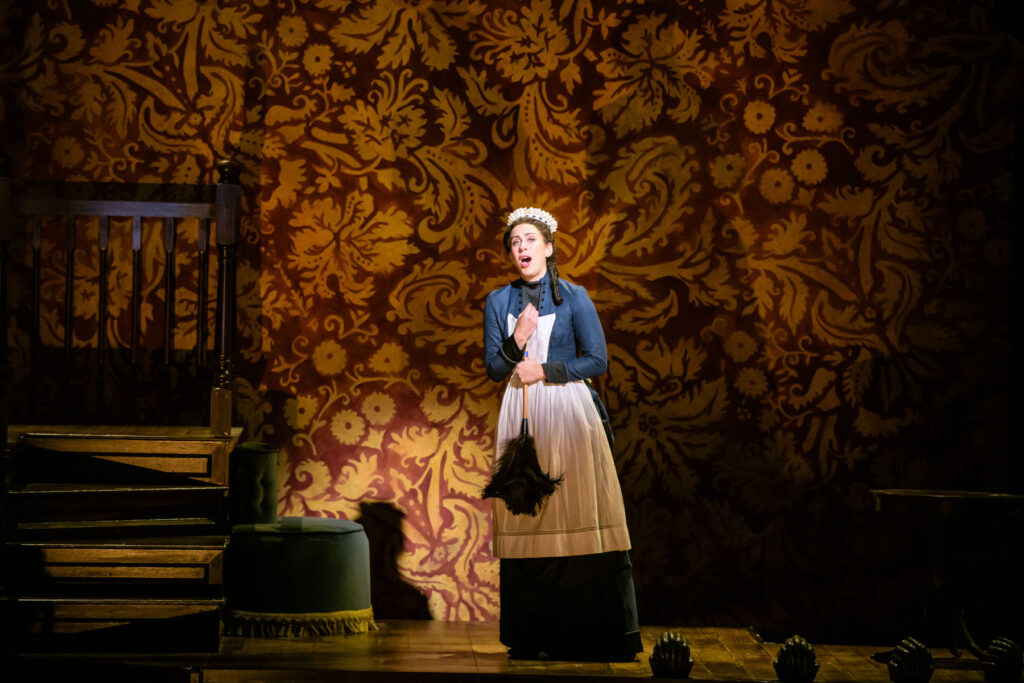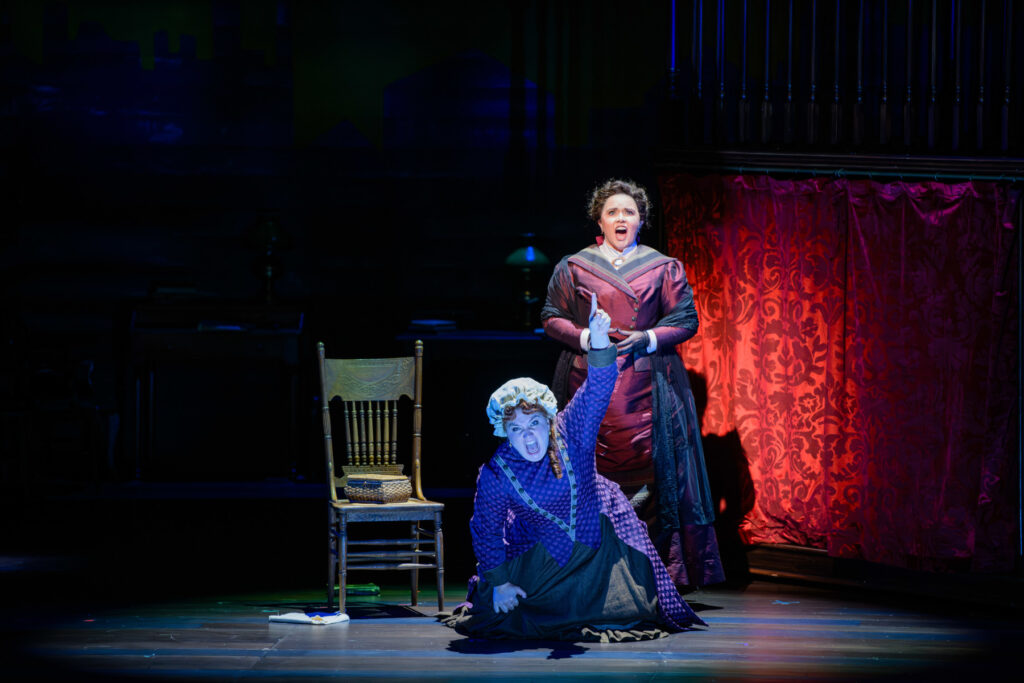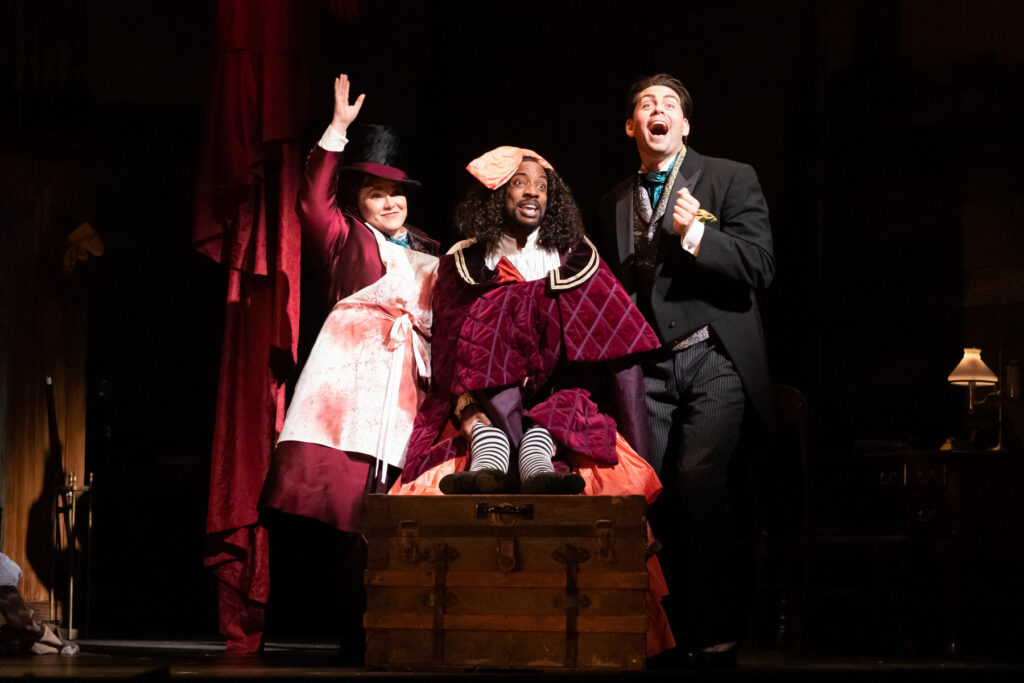Producing festival quality opera in these challenging times for the arts can be murder, but Glimmerglass is knocking ‘em dead with its thrilling and fulfilling new production of Elizabeth Cree.
When this taut one act by Pulitzer Prize winners composer Kevin Puts and librettist Mark Campbell premiered in 2017, I enthused that the remarkably good piece “assuredly deserves a bright future of subsequent productions.” The electrifying rendition on stage at the Alice Busch Theatre cements its stage worthy excellence.
I further wrote in my first impressions:
“No spoiler alert needed, the opus starts with the hanging of Elizabeth as punishment for the murder of her husband John. Set in London, 1887-1881, the tale subsequently unfolds in twenty-nine cogent scenes that go back and forth in time, narrating the murder mystery in mosaic fashion, interweaving titillating red herrings, finally revealing the truth in a shocking confession. Even better than Mr. Campbell’s often witty, always riveting text, Mr. Puts’ eclectic score falls tunefully on the ear one moment and is eerily stomach-churning the next. Borrowing from several styles and influences, the talented composer re-invents them with excellent effect to present his own unique voice.”

But I find my opinion has changed. Upon this second experience, I found it even richer than before, with Mr. Puts’ haunting and theatrically vivid phrases and inevitably unfolding musical effects moving forward with inexorable purpose, and Mr. Campbell’s text now a settled mature masterpiece of a diabolical brainteaser.
It was cast from strength, starting with the estimable internationally acclaimed mezzo-soprano Tara Erraught in the title role. Ms. Erraught is the Glimmerglass Artist in Residence this summer, and if her galvanizing performance as Elizabeth is any indication, she has served as a shining inspiration to the entire company, not least the members of the Young Artist studio. Her plush, commanding delivery dominated the proceedings, and she ravished us with her luscious tone, impressive substance, and admirable range. The creators have endowed this devilishly complex character with an emotional gamut that gallops back and forth from youthful ambitions to co-dependent anxiety to Music Hall verve to implied abuse to the comforts of a loving extended family and many nuanced moments in between.
Who is Ms. Cree? An orphaned waif worthy of our pity? A hapless homeless wanderer whose good fortune makes her an unlikely Music hall star? A budding young woman who attracts favorable attention and seems to marry well? A victim who experiences loss after loss with stoicism and resolve? Or is she not as she appears? Ms. Erraught commands the multi-layered dramatic demands with assurance and invests her singing with subtle shading in the wide variety of styles she has been given to vocalize, whether arching lyricism, British popular entertainment spunk, potent dramatic tirades, or heavenly legato passages. Hers is an exceptional instrument, and this definitive role proves a profoundly apt showcase for her gifts.

Matching Erraught’s flashy firepower and commitment note for note, baritone John Chest was superb as Elizabeth’s husband, John Cree. Mr. Chest’s initial urbane intonations as the character wooed Elizabeth were ingratiating and winning. But Chest’s initial smooth pages could not have prepared us for the scorched earth lightning bolts of venom he subsequently hurled with chilling, Thor-inspired alacrity, nor the sinuous, mesmerizing malintent weighting his poised descriptions of several gory murders. Is he what he seems, or is Cree a pawn in a lethal and capricious game?
Tenor Christian Mark Gibbs threatens to steal the show on several occasions with a multi-talented tour de “farce” as the lithe, artful Dan Leno. Hot off his triumphant performance as Frederic in the prior evening’s Pirates of Penzance, Mr. Gibbs further proved that his awesome arsenal of merged musical theatre and opera acumen could perfectly enliven and inform Leno’s many stylistic demands. Not only is he called upon to create a believable Music Hall headliner with some pretty evocative musical show selections, but he also serves up several drag appearances with relish in the time honored British tradition. That is not to suggest Gibbs ever descends to slumming; he knows exactly how to color his well-schooled tenor to wonderful dramatic purpose without distortion, and his innately engaging instrument caresses any number of honeyed phrases, even as he invests the character’s “off stage” humanity with heart and genuine concern.
As Inspector Kildare the assertive baritone Schyler Vargas has a self-assured vocal presence conveying an effortless, burnished authority. Mr. Vargas is a gifted actor as well, as evidenced by his playful manipulations as the self-serving detective. Elizabeth Sutphen, the charming, poised soprano that had flawlessly played Mabel in Pirates, here again deployed her shimmering, pliable vocalizing to fine effect as the Music Hall ingénue, Aveline Mortimer, singing with utmost security and sheen, especially in several memorably jaw-dropping stratospheric flights of fancy. Ms. Sutphen also injected some real toughness and emotion into the plot with her vengeful, bold-as-brass testimony at Elizabeth’s trial.
Elizabeth begins her escape from poverty by first getting a job as a prompter at the Music Hall, where other on- and backstage denizens include Uncle (Jason Zacher, sporting a powerful and polished, rolling bass-baritone), Doris (Emily Harmon, showing off a Horne-like, rock solid mezzo in all registers), and Little Victor Farrell (Seiyoung Kim, with a lean, bright tenor of good ping and presence). A highly gifted roster of soloists rounded out the cast, successfully doubling all of the other parts. Evan Lazdowksi (Mr. Greatorex/George Gissing/Etcher) ; Thomas Shivone (Mr. Lister/Karl Marx/Solomon) scored with his substantial bass-baritone; Daniel Taylor (Priest/Librarian/Mr. Gerard) proved a mellifluous, throbbing bass-baritone of exceptional talent you should certainly watch for; Ruby Dibble (Jane Quig/Annie the Serving Girl) impressed with her dark-hued, plummy and rich mezzo-soprano; and tenor Tristan Tournaud (Priest/Librarian) completed the uniformly fine singing cast offering confident, bright, lyric vocalizing. A non-singing mute actor, Carly Rae Carillo was an effective theatrical presence as the Young Lizzie.
Kelly Kuo led a taut, propulsive reading in the pit, relishing the sweep of the soaring passages, investing the Music Hall pastiche numbers with jaunty verve, and beautifully controlling the dark, sinuous churnings without descending into indulgent melodrama. Maestro Kuo’s Festival Orchestra played the lean and mean chamber instrumentation with assured precision, the strings shining, the winds and brass contributing beautifully rendered accentuations and soli. Mr. Puts has crafted some stunning effects with his various combinations and reconfigurations of voicings, and his use of the harp was especially noteworthy, its haunting beauty suggesting otherworldly surrealism with breathtaking immediacy. Too, the keyboard work from Christopher Devlin often claimed sudden moments in the forefront, sometimes tumbling forth alone as he leaves the orchestra momentarily behind and plays characterful soli that are as unsettled and reflective as the moody central character. Kuo also partnered with, and cued his cast with impeccable control and his inspired reading of this compact tale made the 95-minutes go by with a perfectly paced momentum.

The physical production was a terrific environment for this ambitious storytelling. The set must be able to suggest constantly changing, multiple locations, and Edward T. Morris has obliged by placing a handsome, round dark wooden structure center stage, that is one part Music Hall stage platform, one part Victorian mansion, one part courtroom with elevated witness stand, and oh yes, a gallows. Mr. Morris’ inventive revolving structure benefits from being constantly re-dressed with fluidly moving period furniture and set pieces. The clarity of time and place of the episodic shifting is enhanced by a sign posted up stage right that rotates the ‘”year” to keep us grounded in the right framework.
Kate Ashton’s accomplished lighting design ably suggests a whole kaleidoscope of telling effects; at times, moody shadows suggest Lizzie’s troubled soul; then the warm hearth of a proper home; here a garish popular entertainment venue; there a nauseating witness to the aftermath of a murder. It is to Ms. Ashton’s great credit, that through her commanding use of area washes and lovingly calibrated specials, the key moments were always pointed up and well illuminated. The projections were not separately credited, but they were potent partners in creating the impact of the design. It was a riveting effect to project sputtering, stuttering key words randomly on the back wall, excerpted from murderous diary entries that chillingly depicted an unhinged mind at work. Amanda Seymour’s costumes were models of their kind, accurate to the period, appropriate to the various social classes of the wearers, and unfailingly essential in assisting the performers in communicating their unique stories. The rich attention to detail extended to Tom Watson’s exquisite hair and makeup design.
All of this embarrassment of riches was seamlessly stitched together by the inspired stage direction from Alison Moritz, who has combined clarity of storytelling, unparalleled variety of stage pictures, well-developed character relationships, and a laser focused sense of artistic purpose to wring the most artistry possible from this captivating musical murder mystery. I loved both Ms. Moritz’s and choreographer Emma Sucato’s use of the ensemble as frequent observers lurking in the distance. Their silent witness and plodding regrouping suggested not only menace, but also the promise of eventual justice.
Thanks to Glimmerglass Festival’s committed, and beautifully resourced production of this highly worthy newer work, Elizabeth Cree proved to be musically magical, and murderously good.
James Sohre
Elizabeth Cree
Music by Kevin Puts
Libretto by Mark Campbell
Adapted from Peter Ackroyd’s novel Dan Leno and the Limehouse Golem
Elizabeth Cree: Tara Erraught; Dan Leno: Christian Mark Gibbs; John Cree: John Chest; Aveline Mortimer/Witness #1: Elizabeth Sutphen; Doris/Witness #3: Emily Harmon; Little Victor Farrell/Witness #4: Seiyoung Kim; Inspector Kildare/Witness #7: Schyler Vargas; Mr. Greatorex/George Gissing/Etcher/Witness #8: Evan Lazdowski; Uncle/Witness #9: Jason Zacher; Jane Quig/Annie the Serving Girl/Witness #2: Ruby Dibble; Priest/Librarian/Witness #5: Tristan Tournaud; Young Lizzie: Carly Rae Carillo; Conductor: Kelly Kuo; Director: Alison Moritz; Set Design: Edward T. Morris; Costume Design: Amanda Seymour; Lighting Design: Kate Ashton; Hair and Makeup Design: Tom Watson; Choreographer: Emma Sucato
Top image by Sofia Negron.